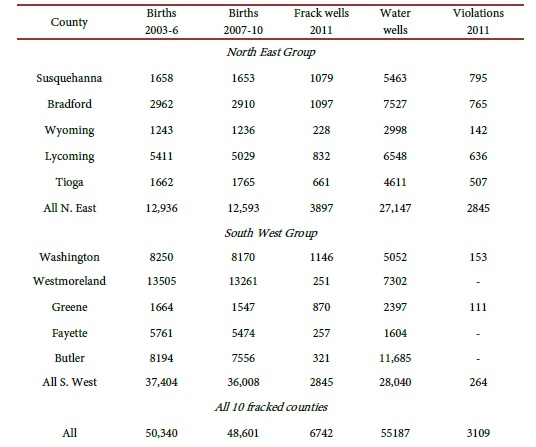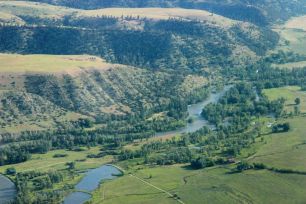A new study published this week in the Journal of Environmental Protection shows, for the first time, a clear correlation between fracking and the death of newborn infants.
The study investigated the association between fracking and the deaths of infants aged 0-28 days by county in Pennslyvania. The researchers compared early infant mortality during the period 2007-2010, after the fracking boom was in full swing, with a control period 2003-2006, before widespread fracking began. It further compared results in the ten most heavily fracked counties with the rest of Pennsylvania.
The study showed that infant deaths decreased by 2.4% across the state during this period. However, in the 82,558 births in the ten most-fracked counties, there was a significant increase in mortality (238 vs. 193, a 23.3% increase). These results are statistically significant at a 95% level of confidence.
According to the researchers, “There were about 50 more babies who died in these 10 counties than would have been predicted if the rate had been the same over the period as all of Pennsylvania, where the incidence rate fell over the same period.”
Take a moment to grasp the significance of this. 50 babies died over three years because they happened to be born near a fracked well.
What caused these deaths?
As with many early scientific studies, this study proves only the correlation, not the direct cause of death. This is the way the scientific method works. The initial study shows a correlation; future studies will be required to show a direct cause.
However, data in the study directs areas for future research. The authors suggest that the process of fracking creates produced water, the combination of chemicals injected into the ground by drillers and naturally occurring radioactive chemicals from shale. These chemicals include radium, uranium, thorium, and radon.
According to the authors, “This produced water and backflow returns to the surface with a high load of dissolved and suspended solids including naturally occurring radioactive elements….The contaminated water has to be safely disposed of but this is often associated with violations of legal disposal constraints.”
In other words, the fracking process produces radioactive material that is sometimes not disposed of properly.
There is additional data in the study that suggests why this is important. The ten most fracked counties are split geographically: five are located in the northeastern part of Pennsylvania; five are located in the southwest. The increased rate of infant mortality in the five northeast counties was very large: from 36 to 60, a statistically significant 67%. In the five southwest counties, the increase was from 157 to 178, a much smaller 18%.
What the authors discovered was that what separated the two geographical areas was their reliance on private water wells. In the northeast, the number of water wells per birth ranged from 4.9 to 13.1, while in the southwest, there were many fewer, from 1.1 to 3 per birth.
In other words, many more families relied on private wells in the area where there was the largest increase in infant deaths.
Furthermore, they looked at violations of Pennsylvania laws on water disposal, and discovered that there were many more violations in the northeast than in the southwest, as shown in the chart below from the study:
So this is where the research points us.
In heavily fracked areas where there are more private wells and more violations of disposal laws, there are many more infant deaths.
Christopher Busby, one of the authors, concludes, “A major component of early infant mortality is congenital malformation, e.g., heart, neurological, and kidney defects. These are known to be caused by exposures to Radium and Uranium in drinking water.
“Infant death rates were significantly high in highly-fracked counties in northeast Pennsylvania, those with the greatest density of private water wells, suggesting it is drinking water contamination driving the effect.”
Joseph Mangano, the other principal researcher, added: “These results raise serious questions about potential health hazards of fracking, especially since the fetus and infant are most susceptible to environmental pollutants. This is a public health issue which should be investigated wherever fracking is being carried out or proposed.”
What are the implications for communities dealing with fracking in Montana?
These results add to the growing weight of evidence that we need to develop strong regulations to protect Montana landowners from the potential danger of poorly-controlled oil and gas operations:
- In Stillwater and Carbon Counties, there are no public water systems outside of the larger towns. In fact, in the area covered by the proposed Stillwater zone, all residents depend on private wells. This is similar to the situation in the northeast counties in Pennsylvania, where the greatest increase in deaths occurred.
- We know that the driller most frequently associated with fracking in Stillwater and Carbon Counties, Energy Corporation of America, is one of those frequent violators in Pennsylvania. Their record is long and suspect — from 2005-2014, that company had 66 inspections with violations, 90 separate violations, and 55 enforcement actions, with fines totaling over $80,000 in Pennsylvania . You can download the report by clicking here. According to the report, many of the violations occurred in the ten counties in Pennsylvania that were studied.
- We know that Montana has lax rules for water protection, and for notifying landowners of the chemicals used in fracking.
- There are many spills that take place every year in oil and gas operations in Montana.
Any community in Montana that allows oil and gas operations must take precautions to protect itself.
In Stillwater County, Commissioners are currently evaluating a zone proposal by local residents that would establish regulations to protect the County’s water, agricultural/ranch land, and public health. They will hold a public hearing to the zone later this summer.
More to come…
Related: Unknown unknowns: the disturbing case of Vernal, Utah





David, Vernal, Utah has the highest infant mortality of anyplace in the U.S. and local officials there tried to hide that fact from the public. It never ends. Bob Hilten
Sent from my iPad
>
I’ve written about Vernal in the past (see link at end of post). There is very disturbing circumstantial evidence of very high numbers of still births there. What makes this study unique is that it is peer reviewed scientific evidence.